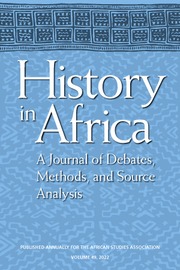No CrossRef data available.
| CARVIEW |
- Home
- >Journals
- >History in Africa
- >Volume 32
- >Reading Ethiopia Through Russian Eyes: Political and...
- English
- Français
Article contents
Reading Ethiopia Through Russian Eyes: Political and Racial Sentiments in the Travel Writings of Alexander Bulatovich, 1896–1898
Published online by Cambridge University Press: 09 May 2014
- Mustafa Kemal Mirzeler*
- Affiliation: Western Michigan University
Extract
It is hard to imagine so many contrasts united in one person, as are united in the Abyssinian character. Their character is like the nature around them-where precipices, cliffs, mountains and plains alternate among one another, and cold is mixed with tropical heat. If I allow myself a rather free comparison, this is how I would characterize the Abyssinian. He is talented and receptive, like a Frenchman. With his practicality, with the way he deals with those he has conquered and his governmental abilities, he is like an Englishman. His pride is like that of a Spaniard. By his love for his faith, his mildness of character and tolerance, he is like a Russian. By his commercial abilities, he is like a Jew. But in addition to all these characteristics, he is very brave, cunning, and suspicious (Seltzer 2000:73).
For us, Abyssinia can present the following interest. Having cast a glance at the map of Central Africa and on the borders of the Ethiopian Empire, you can easily see that being located in the vicinity of the Middle Nile, halfway between Egypt and the great lakes, which belong to England, Abyssinia, which is expanding each year more and more and taking large tracts of land which had been free-rich and densely populated territory-must become the natural and main enemy of England in Central Africa. England is also our enemy. To help the enemy of our enemy, to make him as much stronger as possible-that is our main goal in Abyssinia (Seltzer 2000:144).
Information
- Type
- Research Article
- Information
- Copyright
- Copyright © African Studies Association 2005
Access options
Get access to the full version of this content by using one of the access options below. (Log in options will check for institutional or personal access. Content may require purchase if you do not have access.)Article purchase
Temporarily unavailable
References
Cited by
Loading...
Save article to Kindle
To send this article to your Kindle, first ensure no-reply@cambridge.org is added to your Approved Personal Document E-mail List under your Personal Document Settings on the Manage Your Content and Devices page of your Amazon account. Then enter the ‘name’ part of your Kindle email address below. Find out more about sending to your Kindle. Find out more about saving to your Kindle.
Note you can select to save to either the @free.kindle.com or @kindle.com variations. ‘@free.kindle.com’ emails are free but can only be saved to your device when it is connected to wi-fi. ‘@kindle.com’ emails can be delivered even when you are not connected to wi-fi, but note that service fees apply.
Find out more about the Kindle Personal Document Service.
- Volume 32
- Mustafa Kemal Mirzeler (a1)
- DOI: https://doi.org/10.1353/hia.2005.0017
Save article to Dropbox
To save this article to your Dropbox account, please select one or more formats and confirm that you agree to abide by our usage policies. If this is the first time you used this feature, you will be asked to authorise Cambridge Core to connect with your Dropbox account. Find out more about saving content to Dropbox.
- Volume 32
- Mustafa Kemal Mirzeler (a1)
- DOI: https://doi.org/10.1353/hia.2005.0017
Save article to Google Drive
To save this article to your Google Drive account, please select one or more formats and confirm that you agree to abide by our usage policies. If this is the first time you used this feature, you will be asked to authorise Cambridge Core to connect with your Google Drive account. Find out more about saving content to Google Drive.
- Volume 32
- Mustafa Kemal Mirzeler (a1)
- DOI: https://doi.org/10.1353/hia.2005.0017


